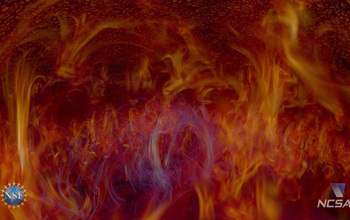Multimedia Gallery
Simulations of magnetic flux emergence, a driver of flares and coronal mass ejections in the sun.
Robert Stein used results of global solar dynamo simulations to determine spatially and temporally evolving bottom boundary conditions for a magneto-convection simulation of the top 15 percent of the solar convection zone (a slab of the sun's surface 48,000 km wide and 20,000 km deep). Magnetic flux emergence in forming solar active regions is the driver of flares and coronal mass ejections that produce the dangerous storms in Earth's space weather. The simulation ran on Pleiades at NASA's Advanced Supercomputing Division. Pat Moran, a visualization expert at NASA Ames, processed the output of these simulations through an advanced algorithm to produce spatially consistent, visually meaningful field lines by selecting for lines that ultimately end up connecting with a particular active region on the sun's surface.
Credit: Robert Stein, Michigan State University
Images credited to the National Science Foundation, a federal agency, are in the public domain. The images were created by employees of the United States Government as part of their official duties or prepared by contractors as "works for hire" for NSF. You may freely use NSF-credited images and, at your discretion, credit NSF with a "Courtesy: National Science Foundation" notation.
Additional information about general usage can be found in Conditions.
Also Available:
Download the high-resolution JPG version of the image. (409.6 KB)
Use your mouse to right-click (Mac users may need to Ctrl-click) the link above and choose the option that will save the file or target to your computer.
Related story: Computational science and data visualization take the spotlight in new documentary



